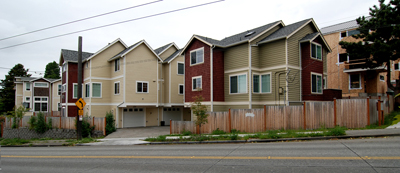We don’t want to make a habit of blogging about adverse architectures in the northwest but the current “townhouse” model here in Seattle is too appalling to keep quiet about. Sprouting up like weeds, the archetype is identified by their auto-courts, separated 3 story structures, bay windows, intersecting pitched roofs, and unusably small decks –all wrapped up in a nostalgic faux-craftsman envelope. In our current buyers market the white picket fence can easily be negotiated into the deal.


This solution to urban density in Seattle has not only become a stagnant model, but it has spread like an urban cancer in the Seattle metro area. Trying to get our heads around the issue, our R&D team took a driving tour to get a better understanding of these crapsman townhouse hobby-kits. We traveled from the U-district to Shilshole and it was shocking how frequently these models populate urban areas like Wallingford, Phinney Ridge, and Ballard.


There has been a lot of finger pointing about the issue. The City of Seattle Department of Planning and Development is often condemned for creating codes which encourage the model. The obvious target is, of course, the developers of these projects who appear to have shed any ethics about urban planning, healthy design and forward thinking. There is also criticism toward the type of homeowner who would financially support such housing. Each avenue is valid to a certain degree but the more we contemplate the issues at hand, the more it seems to be the responsibility of… us, the Architects. At some point in the process an educated, professionally trained, and licensed architect put their stamp on each and every project and turned it in to the City of Seattle.



Obtaining an architectural degree from an accredited school requires a minimum 5 years of undergraduate work. There is a professional board which monitors and accredits architecture programs (NAAB) and a professional organization which administers the professional examination for professional licensure (NCARB). Given the rigor of architecture curriculums and the authority of professional review boards, how is it that we are producing professional architects incapable of designing for the current conditions and time?


Above and beyond keeping the heat in and the water out, we Architects have a responsibility to the institutions that trained us and to society at large for the continued evolution of built-form. As the guardians of the architecture on any given project, it is the Architect’s role to protect the architecture against conflicting motives. This is not to say that the architecture can or should always be dominant –a good project is a balance of many elements, but the architecture should be represented. The Seattle townhouse model, however, shows that all architectural agenda has been forfeited.

Our bet is that these architects know better – that profit, indolence or pleasing the developers got the best of them.
The Seattle Times had a good article on the subject from March 4th, read about it here.





